CIES Football Observatory Monthly Report
Issue no. 13 - March 2016
The fielding of young footballers in Europe
Drs Raffaele Poli, Loïc Ravenel and Roger Besson
1. Introduction
In November’s Monthly Report, we showed how top division European clubs are less and less inclined to use players from their youth academies. This new study aims to find out if the drop in club-trained players goes hand in hand with a decrease in the playing time of footballers under 22 years of age or whether it reflects the rise in national and international mobility from a younger age.
The sample is made up of 31 top division leagues from UEFA member countries. For all of these leagues, we studied the percentage of domestic league minutes played by footballers under 22 years of age between 1st July 2009 and 31st December 2015. A player is part of the U22 category up until the day preceding his 22nd birthday.
The analysis initially focuses on all the leagues studied. It then presents the results for the five continental areas identified. In both cases, we analyse the proportion of minutes played by U22 footballers, as well as the percentages according to the origin of young players fielded (national or foreign). Finally, we focus on the situation by league and present the record values measured at club level.
2. A decrease in young nationals
During the period analysed, footballers under 22 years of age played 14.6% of minutes in the 31 leagues surveyed. On average, out of 11 footballers fielded by teams studied, 1.6 had not yet celebrated their 22nd birthday at the time of the match. No significant change has been noted between the 1st July 2009 and the 31st December 2015. The lowest level of young players was observed during the semester between January and July 2015: 13.7% of playing time. The highest percentage was measured between July and December 2013: 15.2% (fig-1).
Overall, the level of employment of young players does not vary. However, the analysis of the origin of U22 players allows us to highlight a significant change. Over the period studied, the percentage of minutes played by young nationals has diminished at a modest but constant rhythm: 12.0 to 10.7% between the first and last semester of the analysis. The lowest level was recorded during the first semester in 2015: 10.4%.
Contrary to that of young nationals, the presence on the pitch of U22 foreigners tends to increase: 2.8% to a record 3.8% of minutes between the first and last semester analysed. In 2009, imported footballers played less than a fifth of minutes played by footballers under 22 years of age (19.0%, fig-2). During the last semester studied, this proportion went up to over one quarter (25.9%).
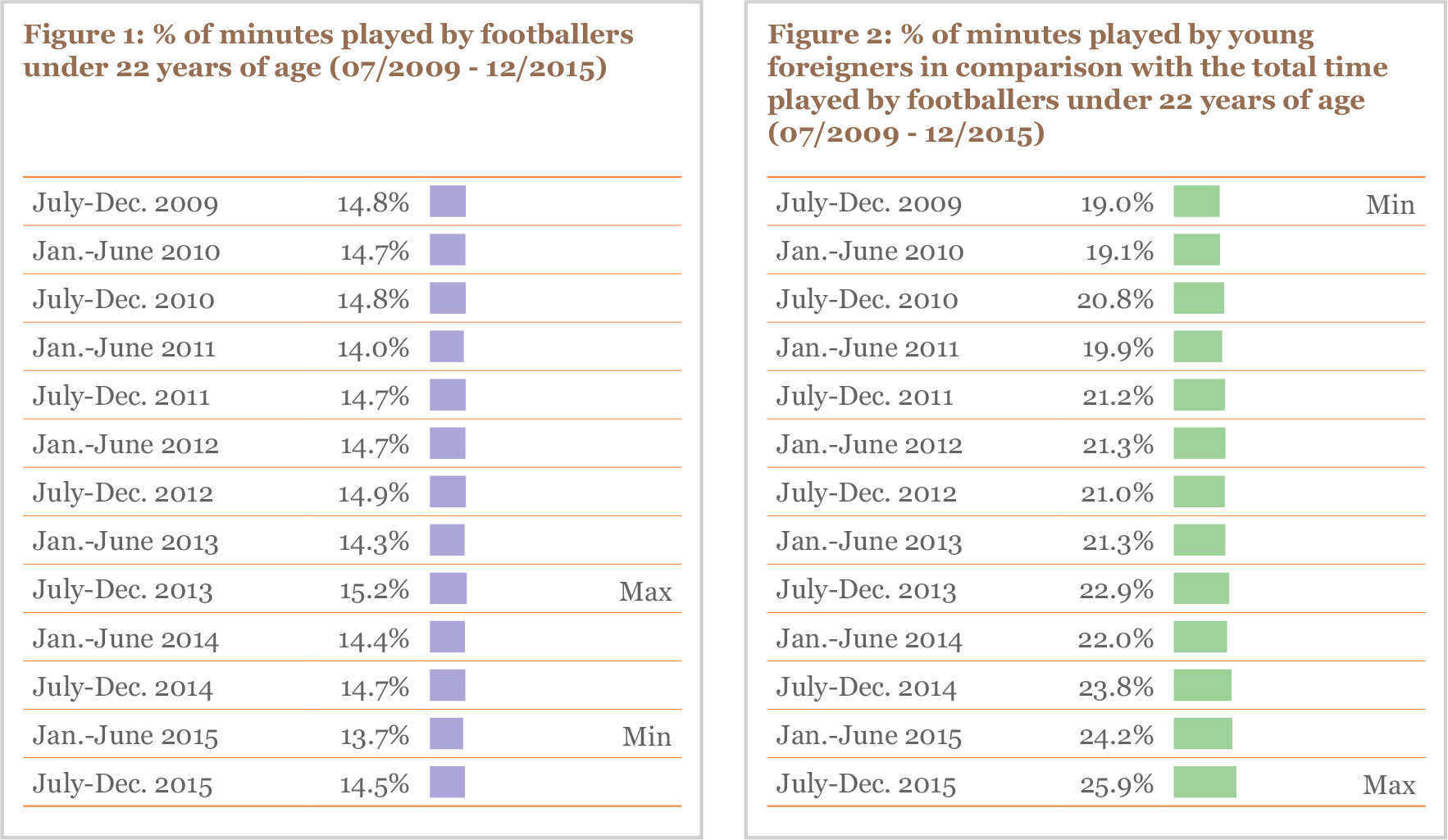
This change underscores the intensification of the international mobility of players from a young age. Between 2009 and 2015, the average age of first international migration of footballers present in the 31 leagues analysed has fallen from 22.2 to 21.7. The percentage of players having moved abroad before celebrating their 22nd birthday among those who migrated over the course of their career increased from 44.9 to 49.6% (fig-3). Players having moved abroad under the age of 18 represented 8.0% of migrants in 2009 and 9.8% six years later.
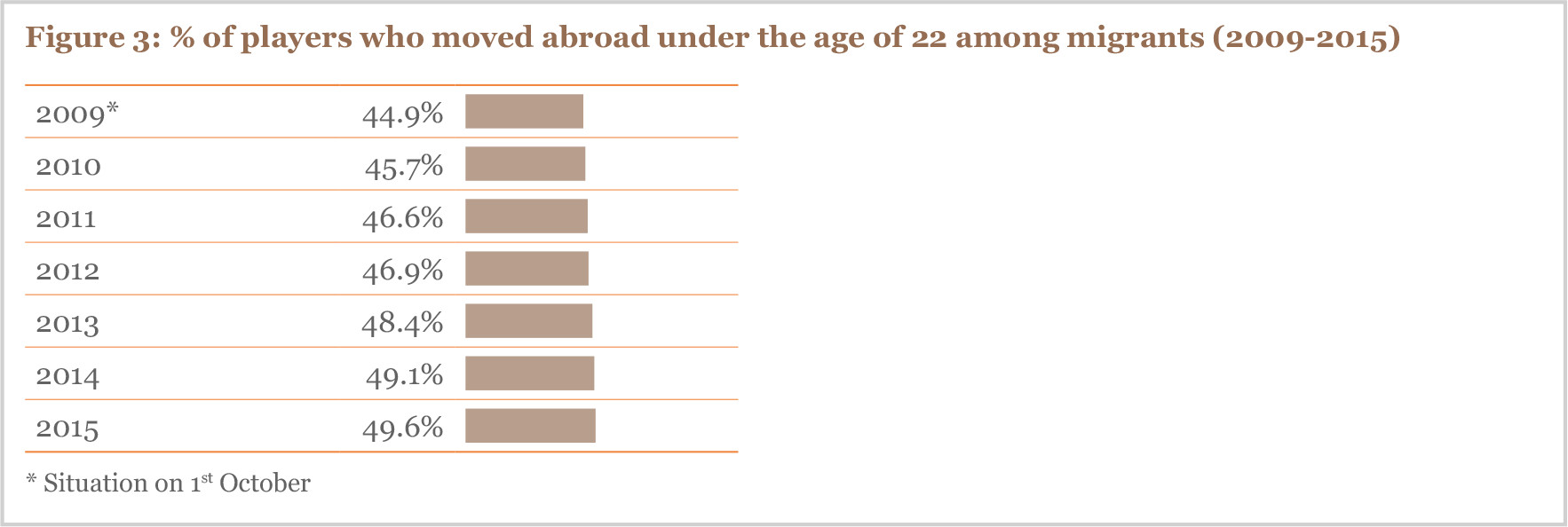
3. The situation from Southern to Northern Europe
An analysis by continental zone allows us to bring to light important spatial disparities. Between July 2009 and December 2015, footballers under 22 years of age played almost one fifth of minutes within top division teams of Central and Northern Europe (fig-4). This proportion was only approximately one tenth in Southern and Eastern Europe. Western European leagues are situated between these two extremes.
During the period studied, the presence on the pitch of players under 22 years of age has fallen slightly only in Northern Europe (from 18.8% during the first semester studied to 16.9% during the last) and in Eastern Europe (from 12.2% to 10.5%). However, the rate of employment of young nationals has fallen everywhere except Western Europe, where it has remained stable at 10.6%.
In all of the continental zones analysed, the relative stability of the employment rate of players under 22 years of age is linked to the increase of minutes played by young footballers imported from abroad. In Southern and Western Europe, the latter represent a significant proportion of footballers fielded by top division teams (fig-5).
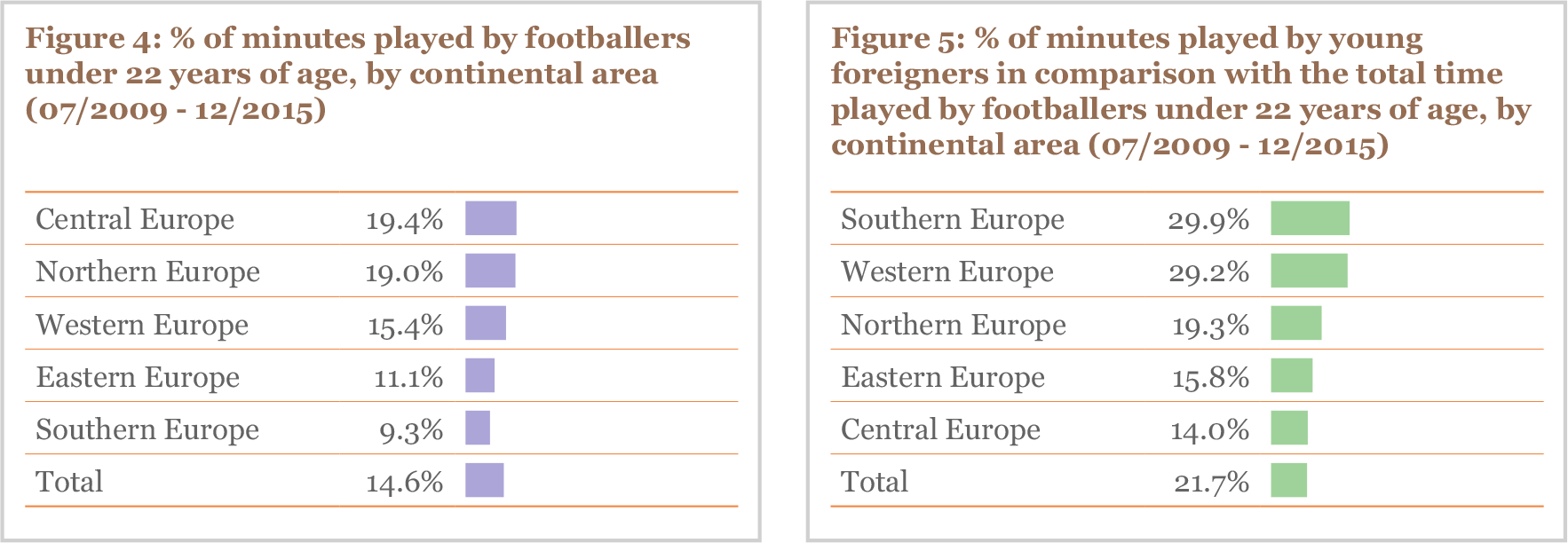
Between 2009 and 2015, the increase in the proportion of minutes played by foreign footballers by comparison to the total playing time of U22 players was particularly marked in Southern Europe: 22.2% during the first semester studied to a record figure of 37.3% during the last (fig-6). This rise highlights the growing tendency of Mediterranean clubs to prefer young foreign players over home-grown ones.
In Northern Europe, young nationals are still relatively numerous. Nevertheless, the relative presence of footballers under 22 years of age imported from abroad has also strongly increased, reaching a peak of 28.3% of total minutes played by young footballers during the last semester studied. Between July and December 2015, new records in the relative presence of foreigners among U22 players have been observed in each of the zones with the exception of Eastern Europe.
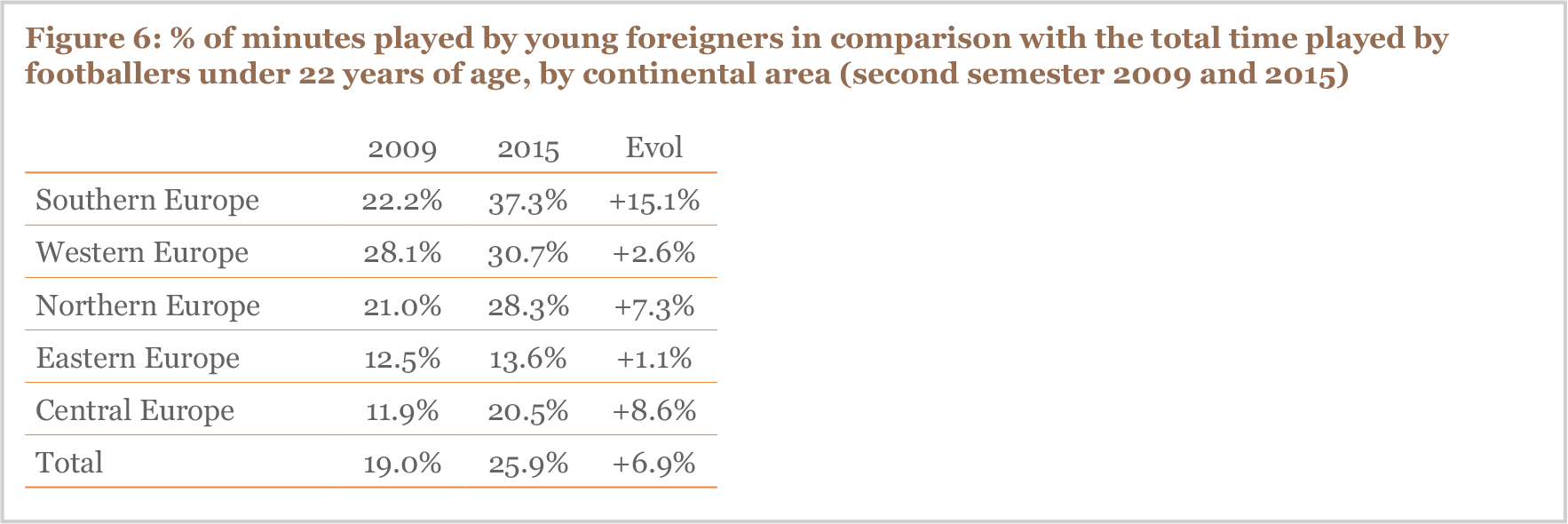
4. Analysis by league: the most and the least
An analysis by league allows us to classify championships surveyed in four categories according to the level of employment of young players (fig-7). The first category comprises leagues where footballers under 22 years of age have played at least 20% of minutes between July 2009 and December 2015. This percentage varies between 15 and 20% for the second category of leagues, between 10 and 15% for the third and is less than 10% for the fourth.
Croatia is home to the league whose clubs have used U22 players the most over the period studied. This category of footballers played 28.7% of the total time: 26.3% for nationals and 2.4% for foreigners. The proportion of young players on the pitch is over one quarter in only one other championship studied: the Slovenian top division (27.8%).
No Southern or Eastern European championships are to be found among the leagues where footballers under 22 years of age had over 20% of playing time. The Dutch top division is the only Western European league among the championships with the most young players on the pitch.
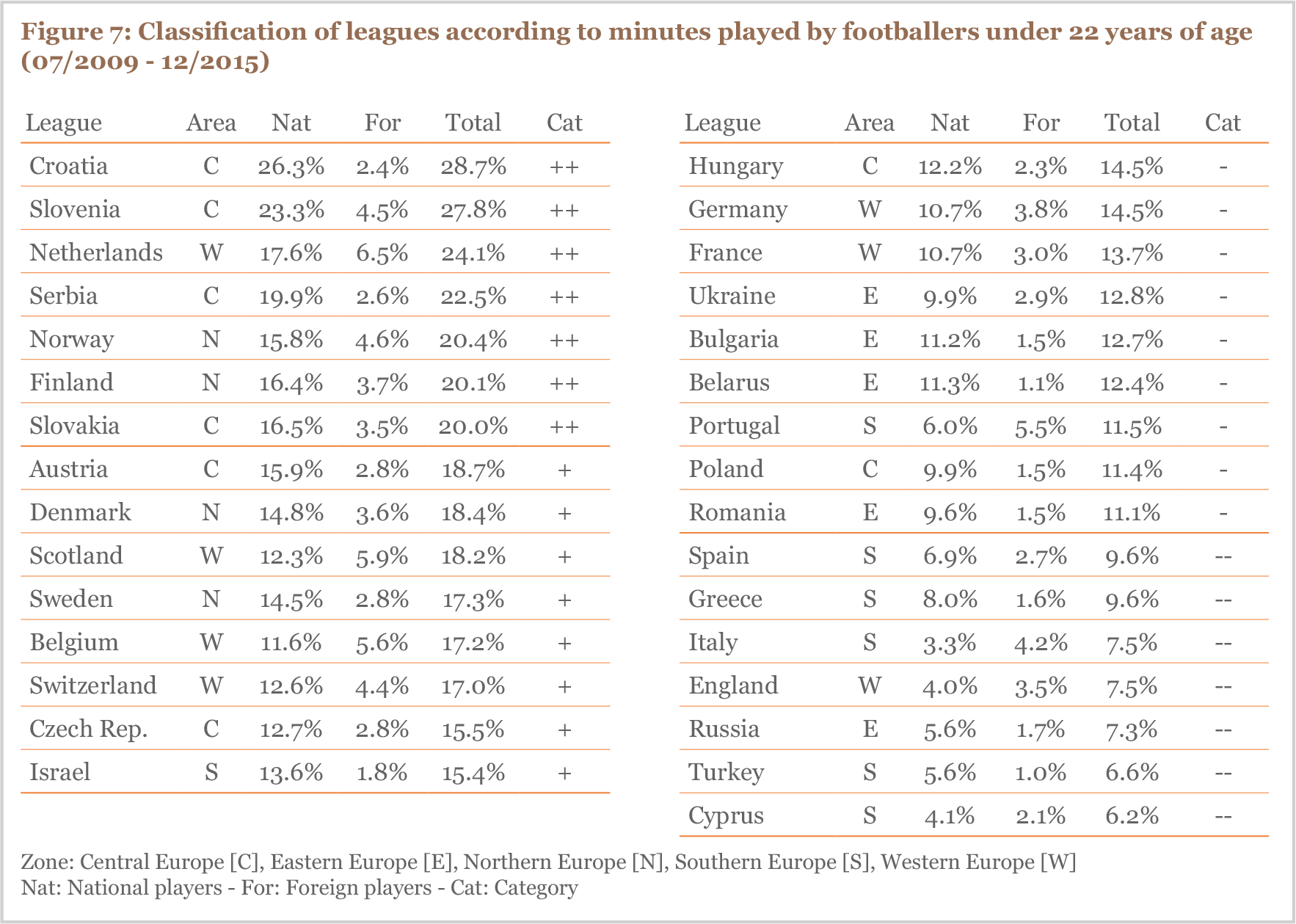
Generally speaking, the proportion of minutes played by national U22 footballers is lower among the most competitive teams. A significant statistical correlation exists between UEFA’s average ranking between 2009 and 2015 and the rate of employment of young national players (fig-8). However, some notable exceptions can be highlighted.
The level of employment of young nationals in the Dutch league is particularly high in comparison to the good performances achieved by its representatives in European competitions. This result reveals, on one hand, the excellent training system that exists in the Netherlands and, on the other, the confidence that local teams have in their young players. Other countries are similar to Holland in this respect, notably Germany, France, Croatia and Spain.
On the contrary, in the Hungarian top division, the use of national U22 footballers is particularly weak with regard to the poor results achieved in European Cups. This situation shows both the need to improve the country’s training system and a mistrust of young players. The same can be said for Cyprus, Poland and Bulgaria. In Belarus and Finland, the problem mainly lies in the quality of training.
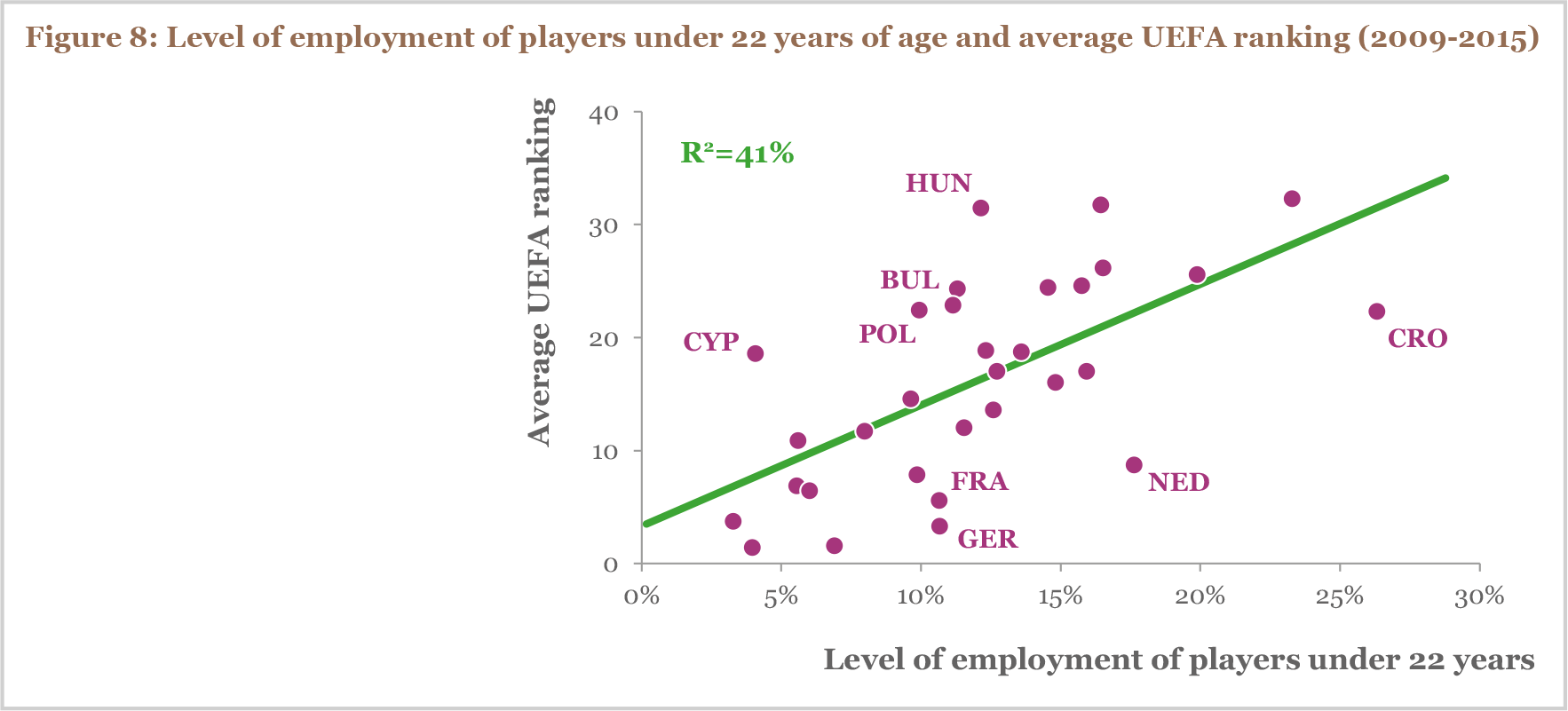
5. Clubs for youths, clubs for veterans
In total, 247 clubs have always been present in the top division throughout the period studied. In 31 of these teams, the playing time of U22 footballers has been over 25% (fig-9). The highest value for all of the period was measured for Lokomotiva Zagreb: 54.2%. This is the only club where young footballers have played the majority of minutes.
No Southern European club figures among those having employed the most young players. There is only one Eastern European club among the teams where U22 footballers played at least one quarter of match time: Litex Lovech. On the contrary, there are numerous Dutch (6), Serbian (5), Croatian (4) and Slovenian (4) teams.
Six teams having reached at least once the group stage of the Champions League since the 2009/10 season are among those always present in the top division during the period analysed where footballers played at least one quarter of domestic league minutes: Ajax, Nordsjælland, Anderlecht, Malmö, Dinamo Zagreb and Schalke 04.
The record percentages of minutes played by U22 footballers are even higher over a single semester. However, very high values cannot always be favourably interpreted. For example, the greatest value overall was measured for the Cypriot club Alki Larnaca during the first half of the 2013/2014 season (83.0%). This club, over the course of the year, scored only two points. In this case, the employment of young players masked serious financial difficulties.
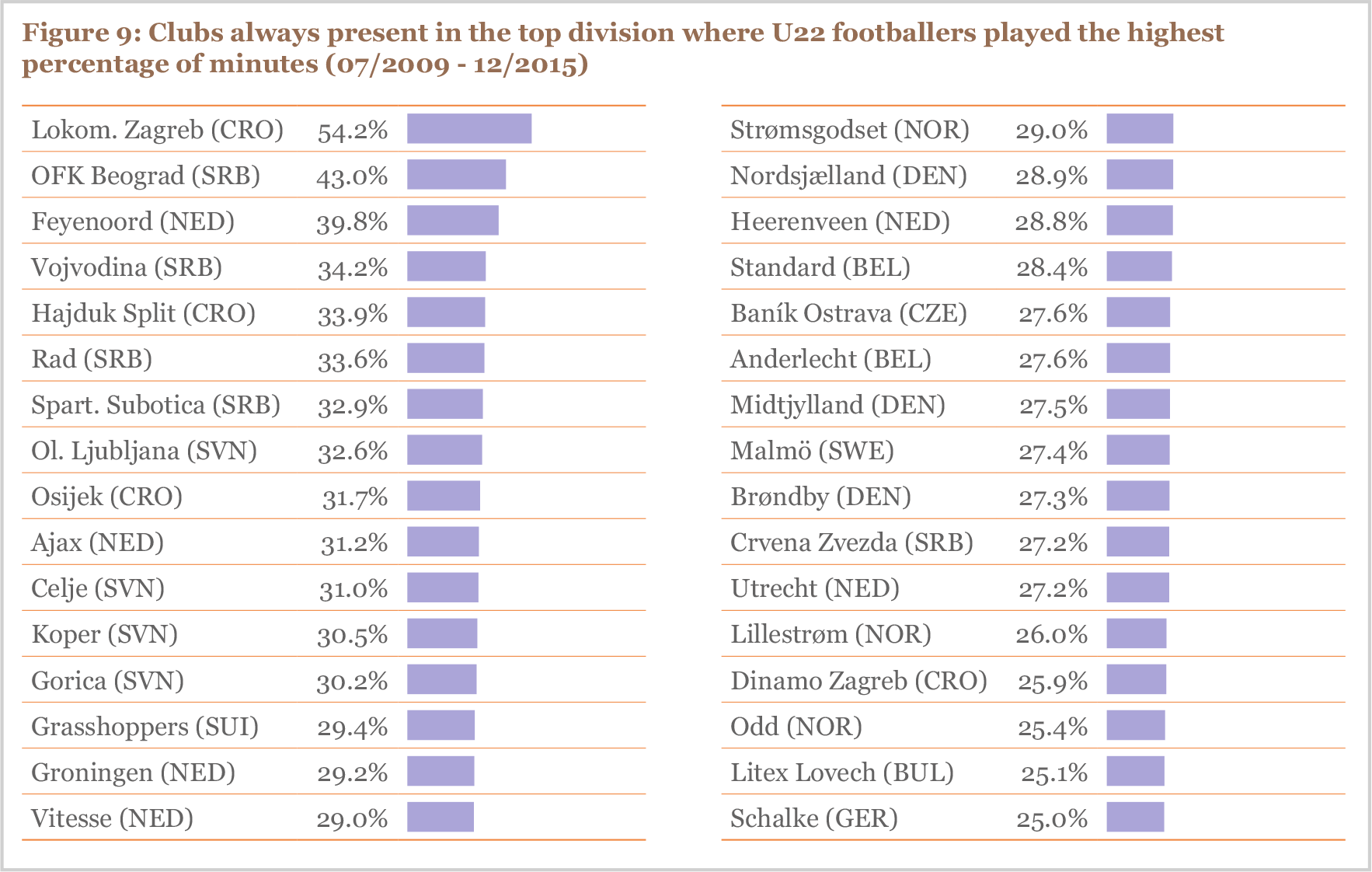
It is also interesting to highlight the clubs that focus on international recruitment of young players (fig-10). Vitesse Arnhem tops the ranking for the highest percentage of minutes played by U22 footballers imported from abroad: 14.9%. The Dutch team is home to many players trained by Chelsea or recruited by the London team from all around the world.
Among the top 20 teams most inclined to field young foreign players are eight clubs who have participated in the group stage of the Champions League at least once between 2009/10 and 2015/16: Ajax, Anderlecht, Basel, Celtic Glasgow, Porto, AZ Alkmaar, Nordsjælland and Twente. All these clubs have access to international recruitment networks through which to attract top level foreign talents.
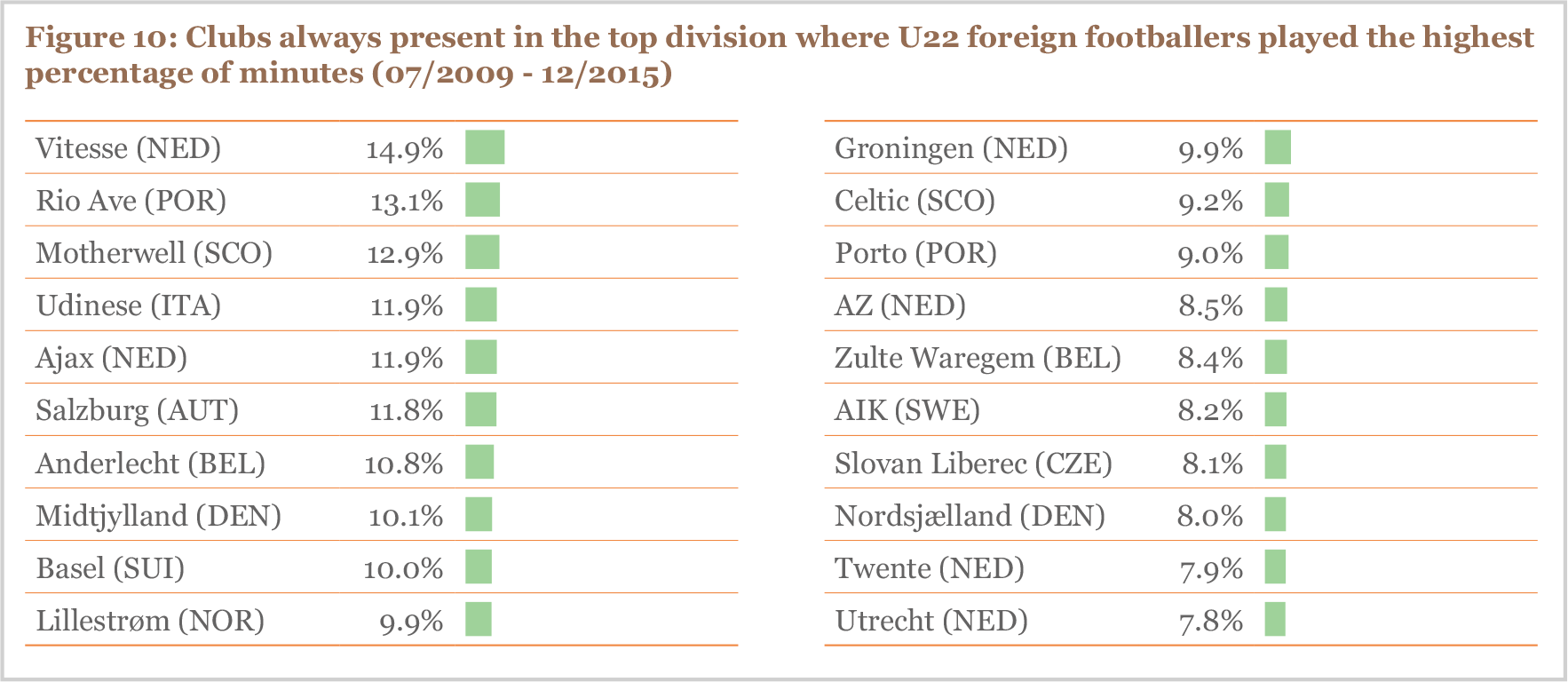
Contrary to the clubs highlighted above, many teams are not overly concerned about fielding U22 players, irrespective of their origin (fig-11). Among the clubs always present in the top division between 2009 and 2015, the lowest value was observed for Stoke City: 0.6% of playing time by U22 footballers. If we only consider nationals, between July 2009 and December 2015, the percentage of minutes by U22 players was less than 3% in 23 clubs, with a minimum for Cypriot side AEL Limassol (0.2%).
European Mediterranean teams are clearly over-represented among those having the least confidence in young nationals. Here we notably find eight Italian clubs, some of which recently participated in the Champions League, such as Juventus, Naples, Fiorentina, Roma and Inter. Numerous other teams recently qualified for this competition are not concerned about giving young nationals their chance: Chelsea, Zenit, Fenerbahçe, Manchester City, APOEL, Porto or Viktoria Plzeň.
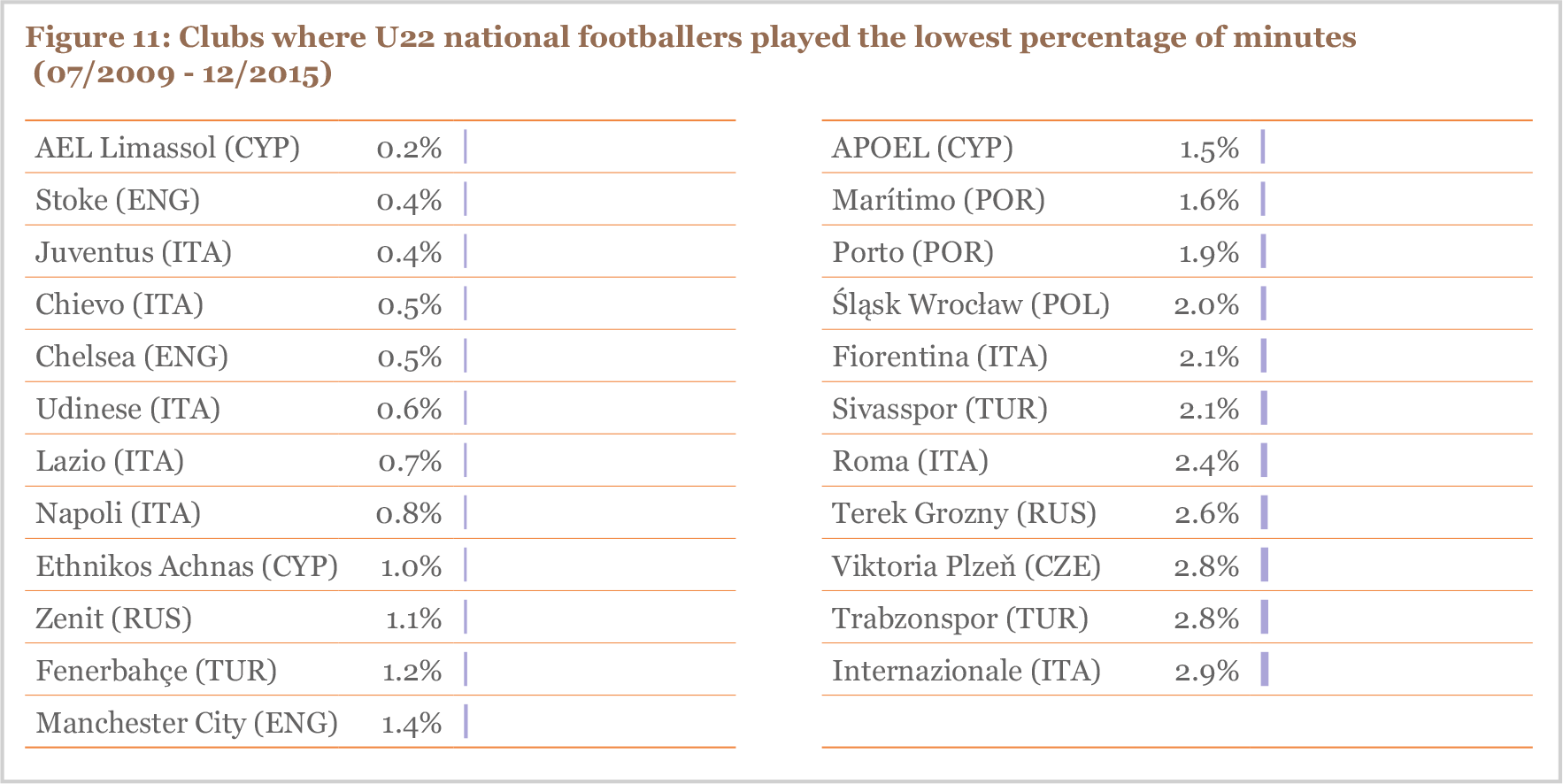
6. Young players at the heart of the market
Our analysis shows that the employment of young footballers does not necessarily go hand in hand with the local training of talents. An increasing number of U22 footballers fielded by teams surveyed do not come from the youth academies of these clubs. This state of affairs reflects the growing mobility of players from a very early age.
Many young footballers are transferred shortly after having made their debut in the first team of their training club. More and more transfers occur even before the footballer has had a chance to play at professional level with the club that trained him.
Training clubs that have limited financial means find it very difficult to hold on to their best talents given the overwhelming financial clout that the wealthiest teams have at their disposal. Conversely, youths trained by the latter are often obliged to leave in order to be able to play.
At the present time, our analysis suggests that training clubs are not sufficiently protected against talent drain. This is problematic not only for training teams and associations, but also for players themselves. Indeed, a premature departure abroad poses serious risks for the development of their career.
Thus, it is necessary to carefully consider regulatory mechanisms to better protect investments in youth training from an economic perspective, and, at the same time, reinforcing the protection of the career of young footballers from the sporting point of view so as to limit as much as possible the waste of young talent.
Monthly Report 13 - March 2016 - The fielding of young footballers in Europe